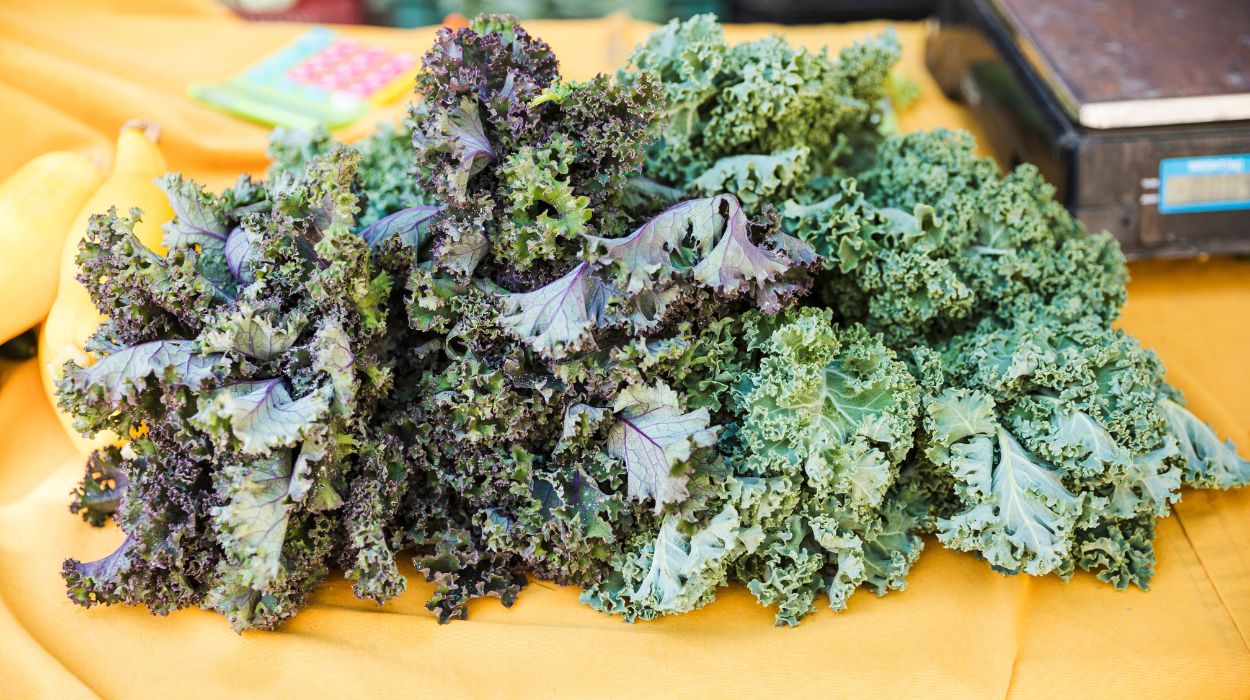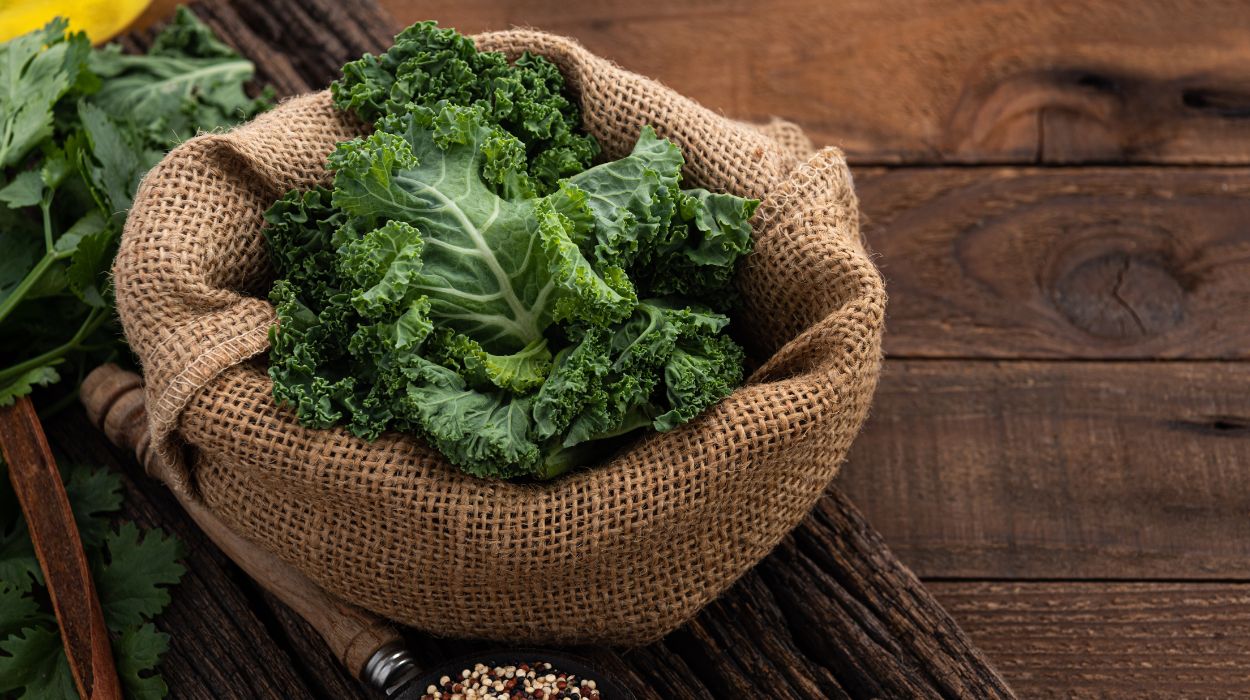 Evidence Based
Evidence Based
Evidence Based
This article is objectively based on relevant scientific literature, written by experienced medical writers, and fact-checked by a team of degreed medical experts.
Our team of registered dietitian nutritionists and licensed medical professionals seek to remain objective and unbiased while preserving the integrity of any scientific debate.
The articles contain evidence-based references from approved scientific sites. The numbers* in parentheses (*1,2,3) will take you to clickable links to our reputable sources.
Is Kale A Superfood? Health Benefits, Nutrition & Risks 2024

Kale is a hardy green leafy vegetable consumed widely across Europe, Asia, and the United States. The multiple varieties[1] of kale of different sizes, colors, and textures vary somewhat in their nutrition profile. These include the popular curly kale, Lacinato (also called Tuscan or dinosaur), and red (also called red Russian) varieties.
Once a hidden star, kale has recently surged in popularity, particularly in the past twelve years[2]. U.S. kale sales were up 10% as of 2020. Kale has been featured in juices, smoothies, and snacks like kale chips and even touted on merchandise like t-shirts and tote bags.
Packed with nutrients and antioxidant compounds linked to a reduced risk of multiple health conditions, kale makes a very healthful addition to your diet. But is kale really a superfood?
Is Kale Considered A Superfood?
Yes, kale can be considered a superfood. It’s rich in nutrients like vitamins A, C, and K, as well as minerals like calcium and manganese. Kale also contains antioxidants and fiber, contributing to various health benefits such as improved heart health, digestion, and immune function. Its low calorie and high nutrient content make it a valuable addition to a balanced diet. Thus, the combination of its nutrient density and health-promoting properties solidify kale’s status as a superfood.
Is Kale A Superfood?
A superfood has no official health definition, but the term generally applies to foods that are high in compounds with health benefits[1]. Kale definitely fits into this category.
So why is kale a superfood? In addition to being rich in multiple crucial vitamins and minerals, kale is full of protective antioxidant plant compounds.
Because of their health benefits, U.S. dietary guidelines recommend consuming 2 ½ cups or more of dark-green leafy vegetables[3], including kale, each week.
Kale is one of the best sources of the plant compounds carotenoids[4]. Carotenoids have antioxidant and anti-inflammatory effects linked to a lower risk of multiple chronic health conditions. Kale is also a good source of other beneficial plant compounds[5], including flavonoids, compounds with potent antioxidant effects.
Kale is a member of the Brassica[6] family. Also known as cruciferous vegetables or the cabbage family, it also includes arugula, broccoli, bok choy, Brussels sprouts, collard greens, turnips, cauliflower, mustard greens, kohlrabi, cabbage, rutabaga, radishes, and watercress[7].
Research has focused on the Brassica family’s high levels of glucosinolates[7], sulfur-containing substances that may prevent cancer.
Nutrients In Kale

Kale is a nutrient-dense food, meaning it has a high amount of nutrients per calorie. It’s also low in carbohydrates. Kale received a high nutrient-density score in a study[8] that compared its nutritional value and amount of fiber, protein, vitamins, and minerals to other veggies.
Kale also contains prebiotic[2] carbohydrates, non-digestible fibers that promote the growth of healthy bacteria in the body for gut health. Adding more kale to your diet makes sense if you’re trying to cut back on calories, are watching your carb intake, or want to improve your gut health.
Although the nutrients[5] in kale can vary based on the variety and growing conditions, it’s an excellent source of vitamin K which is important for blood clotting and bone health, and is a good source of the antioxidant vitamin C.
Kale also provides vitamin A, riboflavin, vitamin B3, vitamin B5, vitamin B6, folic acid, and important minerals like calcium, iron, manganese, potassium, selenium, and zinc. It may contain more nutrients when grown in cooler temperatures.
Kale is higher in many vitamins and minerals than other cruciferous veggies, including calcium, vitamin A, B vitamins, vitamin C, and vitamin K. Kale also has higher levels of vitamin C than other leafy green vegetables. Its calcium content is higher and better absorbed than that of other leafy green veggies.
How To Prepare Kale
What’s the best way to eat kale? Traditionally used[9] primarily as a garnish or in simple salads, the culinary uses of kale have expanded. This once sidelined veggie is now featured in a variety of recipes.
Raw kale can be used in salads or as a topping for sandwiches or burgers. You can add chopped kale to soups, stir-fries, or omelets or bake it into casseroles. Healthy snack options include kale chips, a nutrient-dense alternative to potato chips. Kale juice and smoothies have also become popular.
Drying kale during processing does significantly decrease its nutrient and phytonutrient content[2]. Cooking methods can also affect the content of healthful compounds.
Cooking kale significantly lowers its vitamin C and flavonoid content, though steaming causes the fewest losses. In one study[10], boiling and vacuum cooking decreased kale’s overall antioxidant content while steaming preserved it. Cooking doesn’t seem to affect kale’s mineral content.
One study found that stir-frying kale was the best cooking method to preserve its levels of glucosinolate[11] compounds while steaming and boiling lowered them. Certain cooking methods can also decrease oxalate[10] levels, which may be beneficial for mineral absorption.
Health Benefits Of Kale

A look at the research reveals why kale is a superfood. Kale is not just nutrient-dense, it has some of the highest antioxidant activity[2] of any vegetable. It contains multiple non-nutrient phytochemical compounds with beneficial effects, also known as phytonutrients.
These include compounds that benefit eye health, protect against cancer and heart disease, and have anti-microbial and anti-inflammatory effects. Kale seed contains a compound that may prevent neurogenerative diseases[2].
Kale also contains important nutrients for bone health, including calcium, vitamin K and vitamin C. A small study found that kale juice reduced bone loss[2] in postmenopausal women.
Heart Health
Several of kale’s nutrients and phytonutrients appear to protect cardiac health, including vitamins C and E, carotenoids, polyphenols, and glucosinolates.
Kale also has one of the highest capacities to bind bile acids of a vegetable, leading to beneficial effects on the heart. In addition to its fiber, the phytonutrients in kale appear to play a role in its ability to effectively bind bile acids[12]. In a clinical study[2] of men with high cholesterol, drinking kale juice significantly improved their lipid profiles.
It’s thought that kale and other cruciferous veggies protect against cardiovascular disease by lowering bad cholesterol levels and fighting free radical damage.
Glucosinolates
Cruciferous veggies like kale are also associated with a lower risk[2] of several types of cancer, such as gastrointestinal cancers, cancers of the reproductive and urinary systems, and lung cancer. It’s thought that this is due to their content of glucosinolates.
Kale’s levels of these beneficial plant compounds vary based on growing conditions and developmental stage at harvest but are similar to that of other Brassica family members. The glucosinolates in Brassica veggies have been found to inhibit cancer cells[2].
In lab tests, kale has been shown to have very high anticancer activity, although it’s still unclear how well its anticancer compounds are absorbed or used by the body.
Kale also has antibacterial activity against some harmful microbes. One of the glucosinolates in kale appears to fight the bacteria (H. Pylori) that causes ulcers.
Flavonoids
Kale contains the flavonoids quercetin and kaempferol[5]. These beneficial phenolic compounds are associated with a lower risk of several chronic diseases[2], including obesity, type 2 diabetes, cancer, cardiovascular disease, and neurogenerative diseases.
Flavonoids have also been linked with improved mental and physical performance, increased immunity, and anti-viral, anti-bacterial, and anti-fungal effects.
Carotenoids
Kale is high in the carotenoids beta-carotene, lutein, and zeaxanthin. Carotenoids protect eye health[2], and lutein and zeaxanthin are linked with a lower risk of cataract development and age-related macular degeneration, a progressive eye disease causing vision loss. It’s thought that they decrease eye damage[13] caused by light and free radicals.
Regularly eating kale[14] and other leafy greens may delay the onset of late-stage age-related macular degeneration. However, most Americans do not consume the daily 6 mg[13] of lutein and zeaxanthin recommended for preventing cataracts and age-related macular degeneration.
Kale has the highest documented lutein to zeaxanthin ratio and contains significantly more of these two carotenoids than other fruits and veggies, providing about 22 mg per one cup (raw) serving.
Lutein may also improve cognition[4], including visual processing. Observational studies have found that higher serum levels of lutein and zeaxanthin were associated with a lower risk of developing dementia[13].
A high carotenoid intake has been linked to a lower risk of death[4]. Laboratory studies have found that carotenoids have anticancer and antioxidant activity[2]. This includes protection against the oxidation of harmful cholesterol, suggesting a benefit to heart health.
Potential Risks
Like many plant foods, kale contains some substances known as anti-nutrients that can interfere with mineral absorption. One of these is oxalates, which may cause an increased risk of kidney stones in some people.
However, kale’s oxalate levels are significantly lower than those of chard or spinach[5], and it’s generally not limited to a low-oxalate diet. Cooking further decreases oxalate levels.
The glucosinolates found in kale and other Brassica vegetables are considered goitrogens, meaning they can interfere with thyroid function. However, the risk[14] to healthy people from the amount of these compounds consumed by including kale in a varied diet is considered very low.
The Bottom Line
Kale is a popular vegetable known for its hardiness, culinary versatility, and nutrient density. Kale qualifies as a superfood due to its rich content of essential nutrients and beneficial phytonutrients.
A standout among cruciferous vegetables, kale’s nutrients and phytonutrients have been linked with numerous health benefits and the prevention of multiple chronic diseases.
+ 14 sources
Health Canal avoids using tertiary references. We have strict sourcing guidelines and rely on peer-reviewed studies, academic researches from medical associations and institutions. To ensure the accuracy of articles in Health Canal, you can read more about the editorial process here
- Hahn, C., Howard, N.P. and Albach, D.C. (2022). Different Shades of Kale—Approaches to Analyze Kale Variety Interrelations. Genes, [online] 13(2), p.232. doi:10.3390/genes13020232.
- Šamec, D., Urlić, B. and Salopek-Sondi, B. (2018). Kale (Brassica oleracea var. acephala) as a superfood: Review of the scientific evidence behind the statement. Critical Reviews in Food Science and Nutrition, [online] 59(15), pp.2411–2422. doi:10.1080/10408398.2018.1454400.
- health.gov. (n.d.). Dietary Guidelines for Americans | health.gov. [online] Available at: https://health.gov/our-work/nutrition-physical-activity/dietary-guidelines.
- Hammond, B.R. and Renzi, L.M. (2013). Carotenoids. Advances in Nutrition, [online] 4(4), pp.474–476. doi:10.3945/an.113.004028.
- Cogent Food & Agriculture. (2020). Kale: Review on nutritional composition, bio-active compounds, anti-nutritional factors, health beneficial properties and value-added products. [online] Available at: https://www.tandfonline.com/doi/full/10.1080/23311932.2020.1811048?
- National Cancer Institute. (2022). NCI Dictionary of Cancer Terms. [online] Available at: https://www.cancer.gov/publications/dictionaries/cancer-terms/def/brassica-vegetable
- National Cancer Institute. (2012). Cruciferous Vegetables and Cancer Prevention. [online] Available at: https://www.cancer.gov/about-cancer/causes-prevention/risk/diet/cruciferous-vegetables-fact-sheet
- Di Noia, J. (2014). Defining Powerhouse Fruits and Vegetables: A Nutrient Density Approach. Preventing Chronic Disease, [online] 11. doi:10.5888/pcd11.130390.
- Migliozzi, M., Thavarajah, D., Thavarajah, P. and Smith, P. (2015). Lentil and Kale: Complementary Nutrient-Rich Whole Food Sources to Combat Micronutrient and Calorie Malnutrition. Nutrients, [online] 7(11), pp.9285–9298. doi:10.3390/nu7115471.
- Armesto, J., Lucía Gómez-Limia, Carballo, J. and Sidonia Martínez (2018). Effects of different cooking methods on the antioxidant capacity and flavonoid, organic acid and mineral… [online] ResearchGate. Available at: https://www.researchgate.net/publication/326575142_Effects_of_different_cooking_methods_on_the_antioxidant_capacity_and_flavonoid_organic_acid_and_mineral_contents_of_Galega_Kale_Brassica_oleracea_var_acephala_cv_Galega
- Baenas, N., Marhuenda, J., García-Viguera, C., Zafrilla, P. and Moreno, D. (2019). Influence of Cooking Methods on Glucosinolates and Isothiocyanates Content in Novel Cruciferous Foods. Foods, [online] 8(7), p.257. doi:10.3390/foods8070257.
- Kahlon, T.S., Chapman, M.H. and Smith, G.E. (2007). In vitro binding of bile acids by spinach, kale, brussels sprouts, broccoli, mustard greens, green bell… [online] ResearchGate. Available at: https://www.researchgate.net/publication/43280139_In_vitro_binding_of_bile_acids_by_spinach_kale_brussels_sprouts_broccoli_mustard_greens_green_bell_pepper_cabbage_and_collards
- Abdel-Aal, E.-S., Akhtar, H., Zaheer, K. and Ali, R. (2013). Dietary Sources of Lutein and Zeaxanthin Carotenoids and Their Role in Eye Health. Nutrients, [online] 5(4), pp.1169–1185. doi:10.3390/nu5041169.
- Mrowicka, M., Mrowicki, J., Kucharska, E. and Majsterek, I. (2022). Lutein and Zeaxanthin and Their Roles in Age-Related Macular Degeneration—Neurodegenerative Disease. Nutrients, [online] 14(4), p.827. doi:10.3390/nu14040827.



